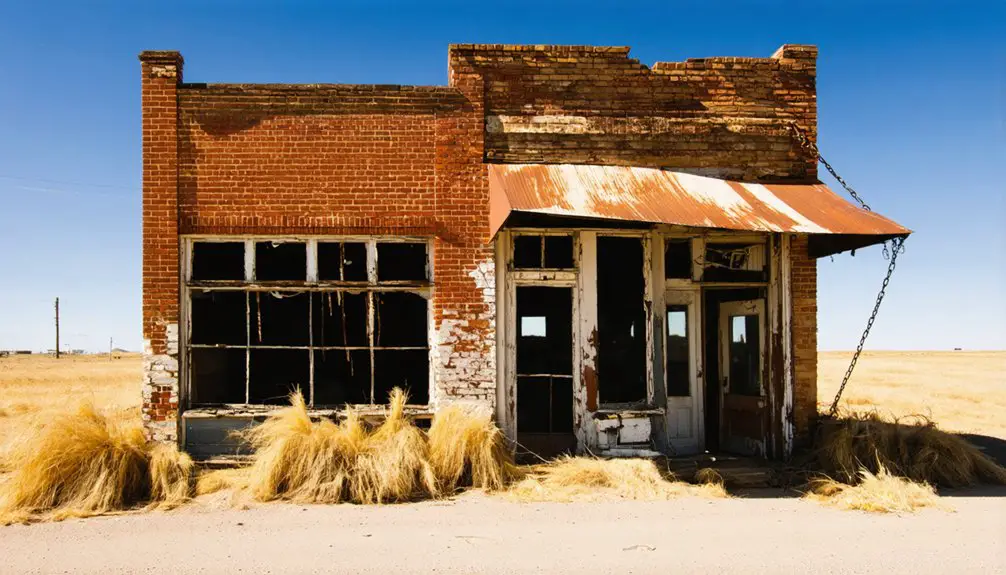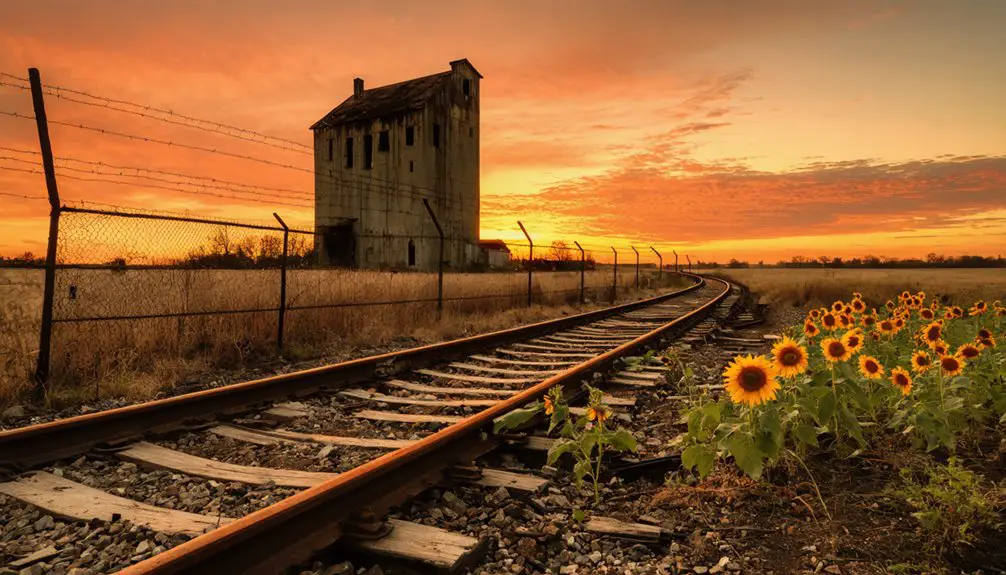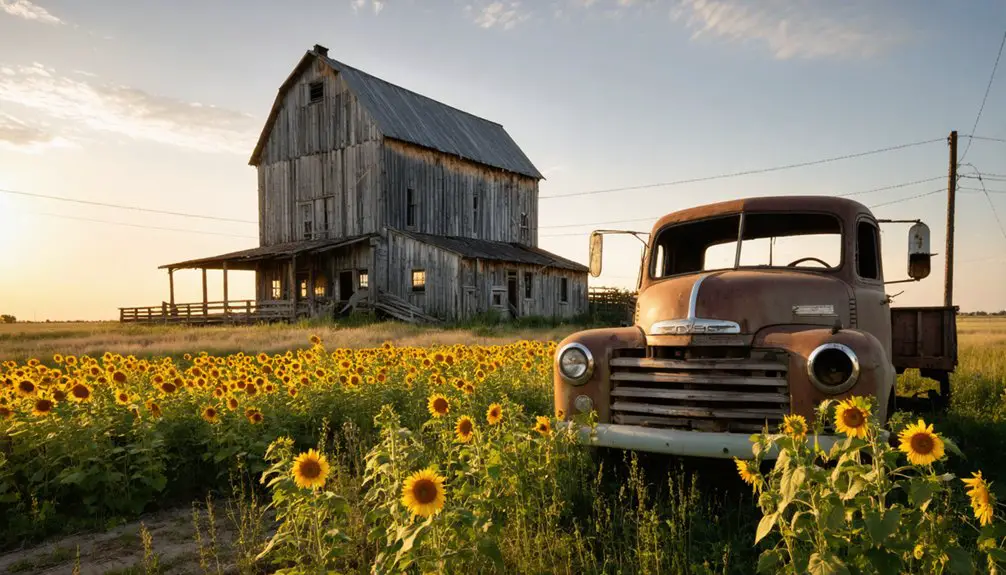You’ll find Avard, Oklahoma seven miles south and six miles west of Alva, where a once-bustling railroad junction town now stands largely abandoned. Founded in 1895 and incorporated in 1904, this agricultural hub thrived until the Great Depression and Dust Bowl dealt devastating blows. Back-to-back tornadoes in the 1940s sealed its fate, and today only 26 residents remain among deteriorating buildings and a supposedly haunted gym, where paranormal activity draws curious visitors to explore its haunting past.
Key Takeaways
- Avard was established in 1895 and became a vital railway junction, but now stands largely abandoned with only 26 residents remaining.
- The town declined due to the Dust Bowl, Great Depression, and devastating tornadoes in 1943-1944, leading to mass exodus.
- Multiple abandoned buildings, including the historic gym and Avard Tribune office, characterize the ghost town’s current state.
- Paranormal activity reports include unexplained footsteps, knocking sounds, and sightings of apparitions in the abandoned gym.
- Local preservationists document the town’s history through photography, oral histories, and organized ghost town tours for visitors.
The Birth of a Prairie Town
In 1895, the establishment of Avard’s post office marked the beginning of a new prairie settlement in what would become Woods County, Oklahoma Territory.
Named after postmistress Isabell Avard Todd’s mother, this budding community embodied the pioneer spirit of the American frontier, situated seven miles south and six miles west of Alva.
The town incorporated in 1904 when the St. Louis and San Francisco Railway extended its line westward through the region.
Like many boomtowns that later declined, Avard represented the optimistic expansion of early Oklahoma settlements.
Railroad Legacy and Agricultural Roots
Railroads transformed Avard from a modest prairie settlement into a key junction point where two major railways intersected. The Santa Fe and Frisco lines converged here, establishing Avard’s railroad heritage as an essential transfer hub by the early 1970s.
You’ll find the town’s strategic position made it faster and more efficient for transcontinental freight operations than alternative routes. Revenue sharing agreements between Santa Fe and Frisco helped solidify Avard’s importance.
Originally established in 1904 when the Frisco Railroad extended through the area, Avard quickly became a transportation center.
Avard’s agricultural significance grew alongside its rail prominence. You could spot farmers hauling broomcorn from up to 40 miles away to the Gerlach Mercantile Company’s warehouse.
Multiple grain elevators dotted the landscape, while cattle and grain shipments flowed north and south along the rail lines. The town’s positioning at this critical railroad junction helped local farmers access wider markets, cementing Avard’s role in the region’s agricultural economy.
Life in Early Avard
Although Avard’s post office opened in 1895, named after postmistress Isabell Avard Todd, the town didn’t truly take shape until its 1904 incorporation following the Frisco line’s connection to the Santa Fe Railway.
You’d have found all the typical frontier businesses there – grocery stores, hotels, restaurants, and the crucial blacksmith shops serving the agricultural community.
If you’d visited in 1909, you’d have been one of roughly 250 residents watching farmers haul their broomcorn to the Gerlach Mercantile Company, sometimes traveling 40 miles to reach town.
You might’ve read the local paper, the Avard Tribune, or stopped by the saloon after a long day.
During the Great Depression and Dust Bowl, the town struggled alongside other Oklahoma communities as severe drought and economic hardship took their toll.
While the editor’s prediction of 3,500 residents never materialized, the town served its purpose as a crucial hub for regional farmers and ranchers shipping their goods by rail.
The Great Depression’s Impact
You’ll find Avard’s downward spiral began as World War I-era agricultural prices plummeted, with cotton dropping from 16 to 6 cents per pound and wheat falling from $1.00 to 38 cents per bushel.
The economic devastation intensified when the Great Depression struck, combining with severe drought conditions and dust storms that decimated local crops and forced many family farms into consolidation or abandonment. Local farmers experienced a devastating 64 percent decline in their farm income during this period. The town’s once-busy grain elevators stood largely idle as agricultural processing ground to a halt.
As farms failed and debts mounted, numerous residents joined the estimated 100,000 Oklahomans who fled to California and other states in search of work, leaving Avard’s once-thriving community to wither.
Economic Devastation and Exodus
When the Great Depression struck Oklahoma in the early 1930s, Avard’s economic foundation crumbled under the weight of collapsing banks, plummeting crop prices, and widespread unemployment.
Local farmers watched helplessly as wheat prices fell from a dollar to thirty-eight cents per bushel, while their loans became impossible to repay. You’d have seen the devastating ripple effect as bank failures cut off credit access, deepening the economic hardship throughout the community. The cost-price squeeze made recovery nearly impossible as equipment and land costs remained high despite falling crop values. Soup kitchens became crucial lifelines for struggling families.
The impact proved too severe for many to endure. Families you’d known for years packed up and left, joining the growing rural migration of “Okies.”
With farm incomes down 64% and over a quarter of the state’s workforce jobless, survival meant seeking opportunities elsewhere, often living in roadside camps as they searched for work in distant cities.
Drought and Farm Failures
As drought ravaged Oklahoma’s farmland in 1930, Avard’s agricultural community faced an unprecedented environmental catastrophe.
Without modern soil conservation techniques or proper crop rotation, the land quickly deteriorated under harsh conditions. You’d have witnessed wheat prices plummet from $1 to just 38 cents per bushel, while cotton fell to a mere 6 cents per pound.
The devastating combination of poor rainfall and deteriorating soil conditions led to widespread crop failures. Local farmers, especially tenant workers who made up over 60% of the agricultural workforce, couldn’t sustain their livelihoods as farm income dropped by 64%.
Like many boomtowns across Oklahoma, Avard’s decline was accelerated by the harsh economic conditions of the era.
With limited public welfare available, many families had no choice but to abandon their farms, marking the beginning of Avard’s transformation from a thriving agricultural hub into a ghost town.
Natural Disasters and Decline

You’ll find Avard’s most devastating natural disasters struck during the 1930s Dust Bowl, when severe droughts and massive dust storms destroyed crops and livelihoods.
Back-to-back tornadoes in 1943 and 1944 delivered crushing blows to different sections of the town, demolishing buildings that were never rebuilt.
These natural catastrophes, following the economic hardships of the Great Depression, accelerated Avard’s transformation from a bustling agricultural center into a struggling community.
Devastating Dust Bowl Impact
During the devastating 1930s Dust Bowl, Avard and other Oklahoma towns faced unprecedented ecological catastrophe that permanently altered the region’s landscape and destiny.
You’d have witnessed the environmental consequences firsthand as massive dust storms swept through the region, stripping away precious topsoil and destroying agricultural productivity.
- Severe drought waves in 1934, 1936, and 1939-1940 devastated local farms, with “Black Sunday” in 1935 darkening skies and terrifying residents.
- Nearly 5 inches of crucial topsoil vanished across 10 million acres, affecting 80% of the High Plains.
- Crop failures and bank foreclosures forced many of Avard’s residents to abandon their homes and livelihoods.
- The combination of the Dust Bowl and Great Depression triggered an exodus, as families sought survival elsewhere, permanently diminishing Avard’s population.
Destructive Tornado Double-Strike
While Avard struggled to recover from the Dust Bowl’s devastation, two powerful tornadoes struck the town in consecutive years, 1943 and 1944, delivering a crushing blow to the community’s survival.
The tornado aftermath left homes, businesses, and public buildings in ruins, with nighttime strikes causing particular chaos as residents confused the tornado’s roar with familiar train sounds.
Despite attempts at community resilience, these back-to-back disasters accelerated Avard’s decline.
The local school district, established in 1894, suffered significant structural damage, eventually leading to its closure in 1968.
Main Street’s buildings crumbled under the combined weight of tornado destruction and neglect.
As rebuilding efforts proved futile against the economic hardships, many residents abandoned their homes, marking the beginning of Avard’s transformation into a ghost town.
The Last Days of Avard School
As rural Oklahoma schools faced mounting pressure to consolidate in the mid-20th century, Avard School’s final chapter began to unfold.
You’ll find the school’s legacy deeply woven into the fabric of this farming community, where for 74 years it served as the beating heart of local education and social life.
- Farm consolidations and improved transportation gave families more schooling options in larger towns
- The Great Depression and Dust Bowl had already weakened enrollment numbers
- Back-to-back tornadoes in ’43 and ’44 damaged local infrastructure
- By 1968, declining population made independent operation unsustainable
When the last class walked across the stage in 1968, they didn’t just carry diplomas – they carried community memories of a school that had persisted through drought, dust storms, and economic hardship since 1894.
Tales From the Haunted Gym

If you’d visited the old Avard gym after dark, you’d have heard the inexplicable footsteps and knocking sounds that locals swear echoed through its empty halls, especially near Vina Rae’s Grill where objects would mysteriously move on their own.
The haunting presence of Coach Dee Reynolds, who continued working in the gym even after his wife’s mysterious death, added to the building’s eerie reputation and paranormal legacy.
The gym’s most frightening tales involve encounters with two distinct spirits: a male entity named Isaac who allegedly tried pushing someone down the stairs, and a headless female apparition spotted multiple times, particularly during a memorable Memorial Day sighting in 2002.
Strange Sounds After Dark
Long after sunset in the abandoned Avard gymnasium, visitors have reported unexplained sounds echoing through its empty hallways.
The haunted echoes and ghostly whispers you’ll hear aren’t just the wind – they’re part of the building’s mysterious character that’s drawn paranormal investigators from Tulsa and Enid.
When you visit after dark, you might encounter:
- Distinct footsteps moving through vacant corridors
- Unexplained knocking sounds near the old café area
- Faint voices that investigators couldn’t attribute to natural causes
- Creaking and moaning that doesn’t match the building’s normal settling
These phenomena, documented during multiple investigations including the notable Halloween 2003 study, have convinced locals like Nan Wheatley that multiple spirits inhabit the gym.
The sounds often coincide with visual anomalies, strengthening claims of paranormal activity.
Mysterious Moving Objects
The haunting sounds of Avard’s gymnasium tell only part of its supernatural story.
You’ll find even more compelling evidence of ghostly interactions in the numerous accounts of objects moving on their own, particularly at Vina Rae’s Grill ‘N Graze, which once occupied the old gym space.
During the 2003 Halloween investigation, two paranormal teams from Tulsa and Enid documented spectral phenomena, including mysterious footsteps and shifting objects.
They identified multiple spirits, including an aggressive male entity named Isaac, known for pushing visitors.
The most intriguing reports come from café patrons and the owner, who’ve witnessed unexplained object movements firsthand.
While investigators’ equipment readings remained quiet, the consistent eyewitness accounts since 1995 suggest subtle manifestations beyond mere electromagnetic disturbances.
Coach’s Haunting Legacy
Among Avard’s most haunting tales, Coach Dee Reynolds’ story echoes through the abandoned gymnasium’s weathered walls.
After his wife’s mysterious death, Reynolds continued coaching basketball in the now-silent gym, unknowingly creating one of Oklahoma’s most intriguing ghostly legends.
The emotional hauntings tied to Reynolds’ presence have led paranormal investigators to document several unexplained phenomena:
- Glowing orbs floating through darkened corridors
- Spectral images captured on film during a 2003 investigation
- An aggressive male spirit known as Isaac
- Mysterious energies believed to stem from Reynolds’ personal tragedy
The gym stands locked today, its empty halls preserving the raw emotion of Reynolds’ loss.
It’s become a powerful symbol of Avard’s decline, where personal tragedy intertwines with the town’s own fading story.
Modern Ghost Town Status

Since falling from its early 20th-century peak, Avard has settled into a status between semi-abandoned and historic community classifications under Oklahoma’s ghost town criteria.
You’ll find standing structures that tell the tale of more prosperous times, including the community tornado shelter that once protected residents from the fierce storms that contributed to the town’s decline.
The ghost town dynamics here reflect a common pattern in Oklahoma: a once-thriving railroad town gradually hollowed out by economic challenges, environmental hardships, and changing transportation routes.
While you can still hear trains passing through, Avard’s cultural significance now lies primarily in what it represents – a symbol of the resilience and eventual transformation of early Oklahoma settlements under the pressures of modernization.
Abandoned Buildings and Their Stories
Standing silently along Avard’s empty streets, numerous abandoned buildings tell poignant stories of the town’s former vibrancy.
You’ll find architectural decay everywhere you look, from the crumbling grain cooperative to the locked gymnasium where Coach Dee Reynolds once led local teams. The old school building, a former source of community pride, now stands in ruins alongside empty storefronts that once housed bustling merchants and saloons.
Decay spreads like rust through Avard’s bones, claiming the cooperative, school, and stores that once made this town whole.
- The historic gym has become famous for ghostly encounters, including reported sightings of a spirit named Isaac.
- Only 26 residents remain, surrounded by deteriorating vacant homes.
- The Avard Tribune’s deserted office symbolizes the town’s lost communal spirit.
- A devastating 1939 tornado accelerated Main Street’s decline.
Preserving Avard’s Memory
As Avard’s physical structures continue to fade, dedicated preservationists and local historians have launched multiple initiatives to safeguard the town’s legacy.
You’ll find community engagement efforts ranging from organized clean-up events to educational tours that bring Avard’s past to life. Local enthusiasts document the site through photography, drone footage, and oral histories, while digital archives preserve fragile documents for future generations.
Despite these efforts, preservation challenges persist. Weather damage, deteriorating structures, and limited funding threaten what remains of Avard’s physical heritage.
Yet through social media groups, school programs, and collaboration with regional historical societies, you can still connect with Avard’s story. Historical presentations, ghost town tours, and online platforms guarantee that even as buildings disappear, the memory of this Oklahoma town endures.
Frequently Asked Questions
Are There Any Surviving Descendants of Isabell Avard Todd Still Living Nearby?
Based on Avard history and Todd family records, you won’t find documented descendants of Isabell Avard Todd living nearby today, though some relatives might exist elsewhere without maintaining local connections.
What Happened to the Original Documents and Records From Avard’s Post Office?
You’ll find most post office historical records were absorbed into National Archives Record Group 28, while local documents were likely lost during office closures or consolidated into regional collections.
Was the Town Ever Considered for Any Major Industrial Development Projects?
You’ll find that while Avard’s industrial potential focused on its rail park development plans since 2004, there’s no evidence of major historical industrial projects besides its early role as a rail and agricultural hub.
Did Any Famous People or Notable Historical Figures Visit Avard?
You won’t find records of famous visitors in Avard’s history. While the town held local historical significance through its railroad days, documented visits from notable historical figures don’t appear in any reliable sources.
How Much Did Property Values Change Throughout Avard’s History?
You’d see property fluctuations from peak values during the 1920s railroad boom to severe drops in the 1930s Dust Bowl. Market trends continued downward as population fell, reaching rock-bottom after 2010’s disincorporation.
References
- https://okmag.com/blog/the-ghost-wears-green/
- https://en.wikipedia.org/wiki/List_of_ghost_towns_in_Oklahoma
- https://www.okhistory.org/publications/enc/entry?entry=AV002
- https://kids.kiddle.co/List_of_ghost_towns_in_Oklahoma
- https://www.youtube.com/watch?v=WKmqMwOawgE
- https://www.okielegacy.net/journal/tabloid/?ID=5530&vol=12&iss=21
- https://okielegacy.net/journal/tabloid/?ID=4773&iss=2&Vol=12
- https://www.trainorders.com/discussion/read.php?1,5445883
- https://oklahomarailwaymuseum.org/wp-content/uploads/2023/03/A-Brief-History-Of-Oklahoma-Railroads.pdf
- https://www.okhistory.org/publications/enc/entry?entry=RA004



